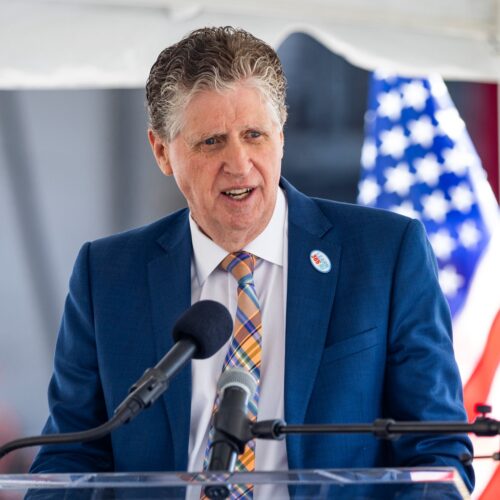A nonprofit used AI to document 77 million miles of unmapped waterways. Here's why that matters.

Courtesy of Bridges to Prosperity/Robb Hohmann
- Bridges to Prosperity helps build trail bridges in rural communities.
- The nonprofit is using AI to map these areas and identify prospective bridge locations.
- This article is part of "Build IT: Connectivity," a series about tech powering better business.
Not all maps are created equal. Huge swaths of land lack basic geographical data, including details as vital as the locations of rivers or roads.
To Bridges to Prosperity, a nongovernmental organization that helps build bridges in isolated rural communities, this data gap meant missing infrastructure.
Since its launch in 2001, the NGO has built or supported the construction of over 600 trail bridges in 21 countries, creating safe, accessible routes to medical clinics, schools, and markets. But building bridges is expensive, so in 2020, it pivoted from independently building bridges to partnering with governments to support their infrastructure efforts. Still, figuring out where bridges were needed was difficult.
Many rural waterways, especially the smaller streams and rivers that isolate entire villages during the rainy season, had not yet been mapped by governments or businesses. After analyzing 5,000 waterways around the world, the organization found that 38% of streams and rivers weren't on any existing maps.
"The rivers that are preventing them from getting to school, getting to markets, getting to clinics, to churches, to visit friends, that literally stops them from doing all those things, is not even a blue line on that map," Nivi Sharma, Bridges to Prosperity's CEO, told Business Insider.
"There is huge data inequity on how much we spend, how much investment we do in mapping certain populations, and how little we do for others," she added.
Bridges to Prosperity turned to artificial intelligence to fill the data gap. First, it built Fika Map, an AI tool that identifies locations where bridges could be built and estimates construction costs, among other capabilities. "Fika" means "to arrive" in Swahili.
The NGO also teamed up with Better Planet Laboratory to create WaterNet, an AI model that maps the world's waterways. They used satellite data to detect elevation and vegetation patterns, which the AI model then analyzed to approximate the location of waterways.
Bridges to Prosperity is using these programs with governments in Rwanda, Ethiopia, Uganda, and Zambia to help plan bridge construction and improve infrastructure across the countries.

Courtesy of Bridges to Prosperity/Shotbygib
Layering the data
Bridges to Prosperity had already been producing maps for areas where it had built bridges. This gave the NGO a starting database of geographical data that it could use and add to in order to build these programs.
"It's really easy to map where communities live by looking at satellite data, and most governments have schools, health clinics, markets, and critical destinations already mapped," Sharma said. "And so we started layering all this information together."
It also used data from less conventional sources, like the fitness tracking app Strava, to calculate travel times over uneven terrain.
But it still struggled to identify smaller rivers and streams.
"High-resolution satellite images are needed for the mapping of waterways in remote areas," said Marouane Temimi, an associate professor in the Department of Civil, Environmental and Ocean Engineering at the Stevens Institute of Technology.
Temimi said there are two types of satellite data. For optical satellite data, cameras capture images of the Earth's surface. Clouds can disrupt this, blocking out target areas. Radar satellite imagery, on the other hand, uses radio waves, which means it can create images even when clouds are in the way. But it can be affected by wind.
The two types of data can be combined to build accurate maps — but they come with a cost. Temimi said that satellite data is usually collected by commercial sensors, so getting the information can be expensive.
Sharma said the NGO had to balance getting quality data with making sure both programs were affordable, scalable, and global.
"The whole argument around AI and its inclusiveness — it's not built with enough good training data," Sharma said. "It often overlooks the entire Global South, which is obviously what we're trying not to do. But that's the expensive part."

Courtesy of Bridges to Prosperity
A tool for change
Bridges to Prosperity and Better Planet Laboratory measured the impact of the dataset by assessing the number of waterways identified. Previously, they estimated that there were 54 million kilometers of mapped waterways around the globe. The WaterNet database mapped another 124 million kilometers, or 77 million miles, which more than tripled the number of known waterways worldwide.
Sharma said that Fika Map and WaterNet could help governments complete surveying work for bridge construction in months, rather than years.
"It's a decision-making tool. It's an advocacy tool. It's a planning tool," she said. "It really tells the full story of rural livelihoods and what needs to be done to improve that development."

:max_bytes(150000):strip_icc():format(jpeg)/jeff-bridges-050225-1-0a8c67ac82b449eda4fb7aa1d92ebdba.jpg)
:max_bytes(150000):strip_icc():format(jpeg)/jeff-bridges-big-lebowoski-050223-1-41e0440e46b4425b8b387b5864b59c08.jpg)
:max_bytes(150000):strip_icc():format(jpeg)/jeff-bridges-performing-041525-88cc6247ada54b57ace3db8f0040af67.jpg)
:max_bytes(150000):strip_icc():format(jpeg)/TRON-Ares-1-080624-7f497db2aeea4d01b63d0a24cd509da0.jpg)
:max_bytes(150000):strip_icc():format(jpeg)/Japanese-Breakfast-02-031425-deb714c05dc445ed82bb587a0d91168f.jpg)
:max_bytes(150000):strip_icc():format(jpeg)/Hiroyuki-Sanada-SAG-Awards-022325-2b6c429e6c8e4013b9d7e2bf8a153bed.jpg)
:max_bytes(150000):strip_icc():format(jpeg)/Todd-Bridges-attends-the-2023-Power-of-Influence-Awards-010725-tout-592e3495a3744b59833dee853d3be109.jpg)
